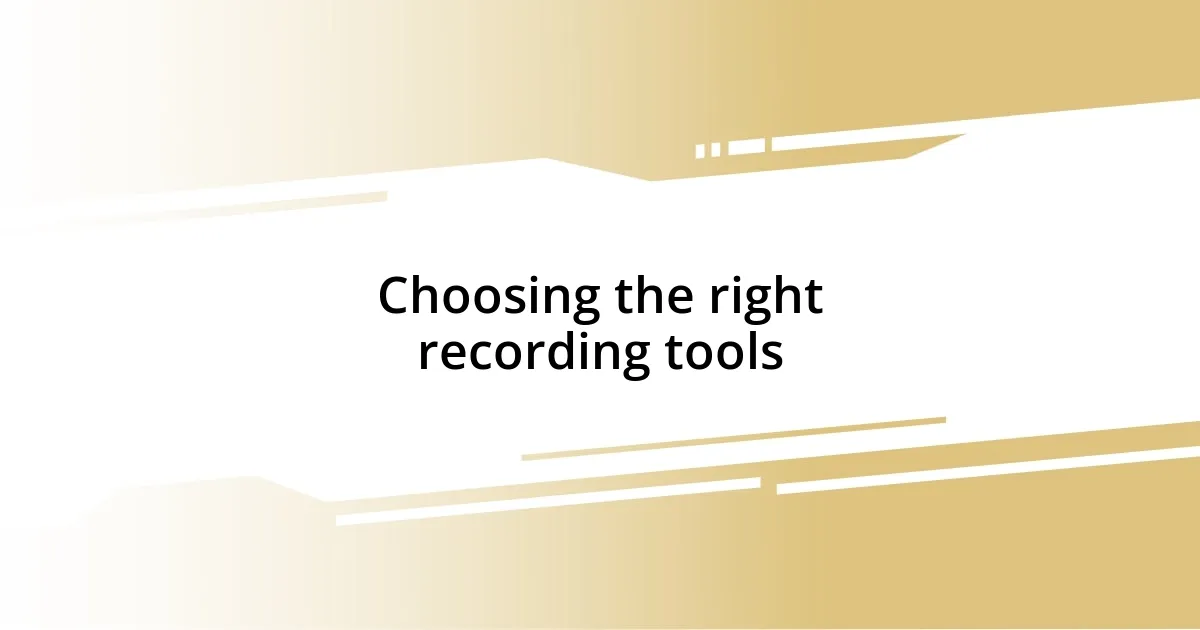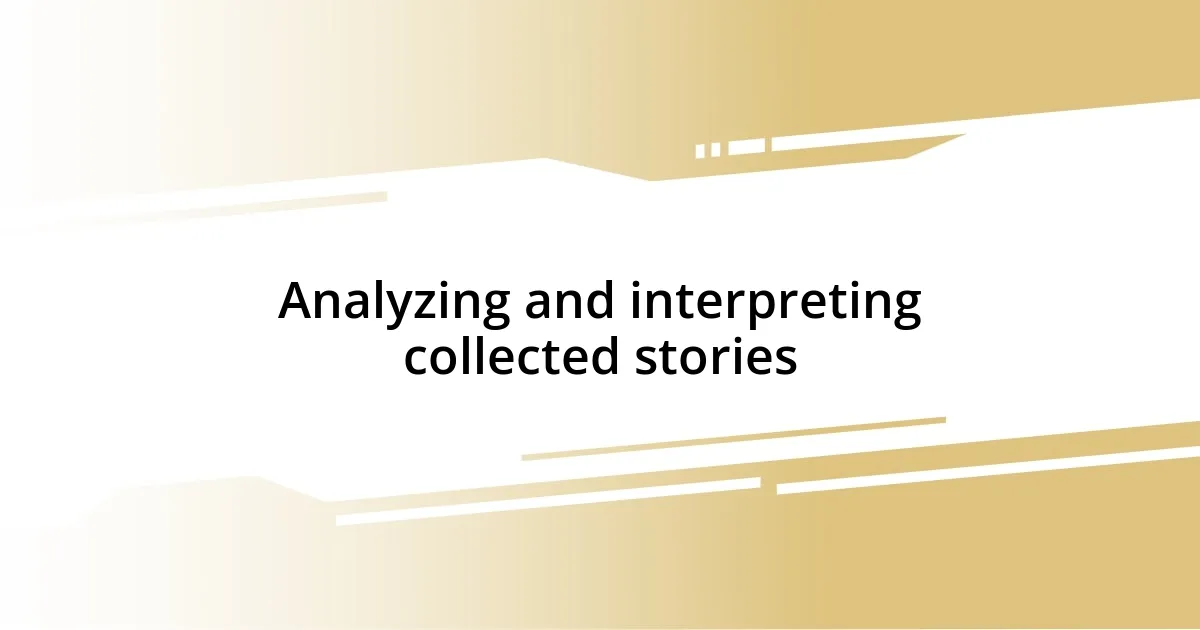Key takeaways:
- Building trust with interviewees and creating a comfortable environment enhance storytelling and emotional depth.
- Choosing high-quality recording tools, such as handheld recorders and lavalier microphones, improves audio clarity and captures vital narratives.
- Effective interview questions, especially open-ended and emotion-driven ones, encourage deeper storytelling and connection with the interviewee.
- Transcription and organization of recordings play a crucial role in preserving the emotional nuances of stories while enabling insightful analysis later on.

Understanding oral history methods
Understanding oral history methods involves a nuanced appreciation of storytelling and memory. I remember my first interview; it felt like unlocking a treasure chest of emotions and experiences. As I listened, I realized that every detail mattered—not just the facts, but the feelings tied to those moments.
In my experience, effective oral history means building trust with the interviewee. Have you ever shared a cherished memory with someone, feeling safe to be vulnerable? Creating that same environment is essential. I often start by asking open-ended questions, which allows participants to narrate their stories naturally. The more relaxed they feel, the richer the narrative becomes.
Choosing the right recording tools is crucial too. I’ve experimented with everything from smartphones to audio recorders. Each time I’ve discovered that the quality of the equipment can significantly affect the experience. Can you imagine losing a vital story because of a technical error? That’s why it’s important to prepare and test your tools beforehand, ensuring that those invaluable voices are captured clearly.

Choosing the right recording tools
Choosing the right recording tools can make a world of difference in your oral history project. When I first started documenting stories, I relied solely on my smartphone, assuming it would suffice. However, during one session, I realized the limitations of the built-in microphone—the ambient noise drowned out the interviewee’s priceless narratives. That experience taught me to value quality over convenience when capturing stories.
There are various types of recording devices available, and each serves a different purpose. High-quality handheld recorders, for instance, often provide superior audio clarity compared to smartphones. While I do appreciate the convenience of digital tools, I find that dedicated audio recorders can truly shine in settings with background noise. They also tend to have longer battery life, which is a huge plus for extended interviews.
I’ve seen colleagues use lavalier microphones to great effect, especially in noisy environments. Wearing a small microphone allows the interviewee’s voice to come through crisp and clear while minimizing distractions from their surroundings. Remember, the goal is to let the story take center stage. Choosing your recording tools wisely sets the stage for preserving those valuable oral histories.
| Recording Tool | Pros |
|---|---|
| Smartphones | Convenient, easy to use |
| Handheld recorders | Superior audio quality, longer battery life |
| Lavalier microphones | Clear voice capture in noisy environments |

Preparing effective interview questions
Preparing effective interview questions is essential for eliciting meaningful stories from interviewees. I’ve often found that my best questions emerge from genuine curiosity. For instance, instead of asking, “What was your job like?” I might ask, “Can you tell me about a moment at work that made you feel proud?” This slight shift transforms the question, inviting the storyteller to dive deeper into personal experiences.
Here’s a quick list that can help guide the process of forming your interview questions:
- Open-ended questions: These encourage expansive storytelling and allow the interviewee to explore their thoughts freely.
- Follow-up questions: Don’t hesitate to ask for clarification or deeper insights based on their responses; it often leads to valuable revelations.
- Contextual prompts: Tailor your questions to specific events or themes that you already know about their life to make the conversation more engaging.
- Emotion-driven inquiries: Questions that tap into feelings, like “How did that experience change you?” can yield profoundly rich responses.
- Prepare for tangents: I’ve learned that the best stories often arise from unexpected directions, so embrace where the conversation naturally leads.
Creating questions with intentionality not only enriches the dialogue but also builds a stronger connection with the storyteller. I remember one interview where I asked a simple, seemingly straightforward question about a family holiday. The storyteller’s face lit up as they recounted unexpected challenges and humorous mishaps, painting a vivid picture of their experience. Moments like these remind me of the power of well-crafted questions—they can truly unlock an interviewee’s treasured memories.

Conducting the interview successfully
Mastering the art of conducting a successful interview hinges on creating a comfortable atmosphere for your interviewee. I remember a time when I set up in a bustling café, and the noise made it hard for my interviewee to focus. It dawned on me that establishing a quiet, private setting could significantly enhance the storytelling experience. Whenever possible, I prefer quieter environments where individuals can feel at ease and speak openly. Have you ever noticed how much easier it is to share personal stories in a relaxed space?
Engagement during the interview is crucial. I’ve learned that active listening goes a long way. When an interviewee senses that you genuinely care about their story, they often share deeper insights. During one memorable session, I’d nodded along and offered small acknowledgments while my interviewee spoke. As a result, they opened up about their childhood dreams, painting a vibrant mural of their past. It made me wonder—how many stories remain untold simply because we’re not fully present during conversations?
Finally, flexibility is essential while maintaining a structured approach. While I prepare my questions carefully, I also embrace the unexpected turns the conversation may take. I once asked about a specific event, but the storyteller veered into a heartfelt discussion about love and loss. It reminded me that the best stories often lie just beyond the initial question. So, are you ready to allow your interview to evolve and explore uncharted territories? This openness can lead to rich, meaningful narratives that resonate.

Organizing and transcribing recordings
Transcribing and organizing recordings is a pivotal part of the oral history process. I’ve always found that a good transcription not only captures the words spoken but also conveys the emotion behind them. For instance, when I transcribed an interview with an elderly veteran, the pauses, the laughter, and even the tremor in his voice at certain memories added layers to the story. But it’s crucial to maintain an organized system to manage these recordings effectively. I typically create separate folders for each interview, making it easier to find materials later on.
Once I start transcribing, I like to replay segments multiple times to ensure accuracy. I remember when I scrambled to capture every word from an inspiring story about overcoming adversity. The details mattered—every inflection, every sigh—because they painted a vivid picture that mere text couldn’t convey. To streamline this process, I also use software that allows me to slow down the playback without distorting the voice. Have you ever tried that? It can make a world of difference in clarifying what was said, especially with stories that burst with emotion or were delivered in a hurried manner.
After the transcription is complete, I take the time to annotate the text. This is where the magic happens! Adding notes about the context or relevant themes helps me connect the dots later, especially when I revisit the material months or even years down the line. I find that, as I reflect on the stories, I may discover new insights or trends across multiple interviews—insights that may not have been evident initially. By keeping everything organized and enriched with my reflections, I create a more comprehensive narrative tapestry that captures the essence of each storyteller’s journey.

Analyzing and interpreting collected stories
Analyzing the collected stories is where the real depth unfolds. I remember a particular instance when I revisited an interview with a former teacher who shared her struggles during a transformative era in education. Going through her words with a fine-tooth comb, I started to see patterns emerge about resilience and innovation. It struck me—how often do we overlook the threads that connect our personal stories to larger historical narratives?
While diving into the details, I often ask myself, “What emotions are driving these narratives?” For example, while analyzing a series of stories from first-generation immigrants, I noted that many carried a sense of pride but also an undercurrent of fear. This complex emotional landscape opened my eyes to the way shared experiences can resonate differently depending on background. Such reflections emphasize the necessity of considering the emotional weight of each story as we piece together the broader picture.
Interpreting the narratives involves more than just understanding their content; it’s about connecting personally with the storyteller’s intention. When I analyzed a particularly poignant tale about loss, I felt a deep kinship with the storyteller’s grief. It sparked my curiosity—how do we weave our individual experiences into the communal quilt of human history? This inquiry encourages me to approach each story with empathy, as I aim to translate their emotions into narratives that not only inform but also resonate deeply with others.














